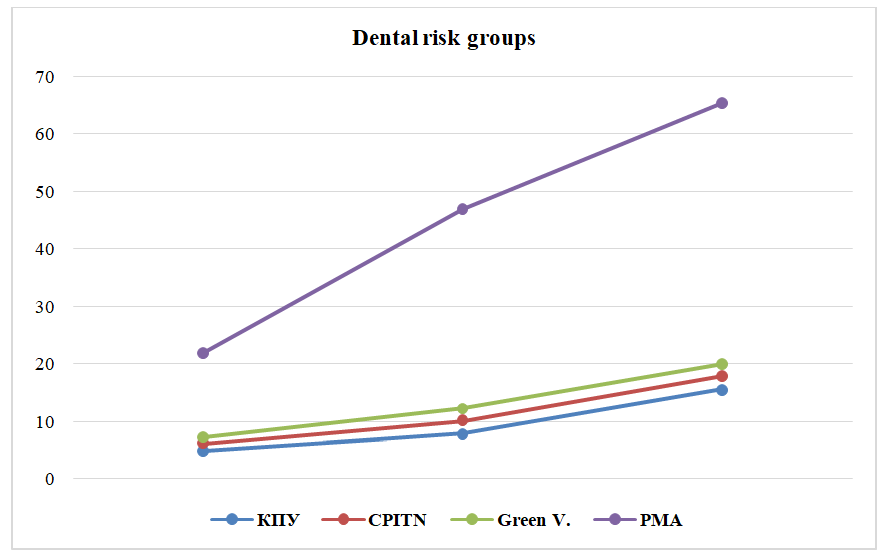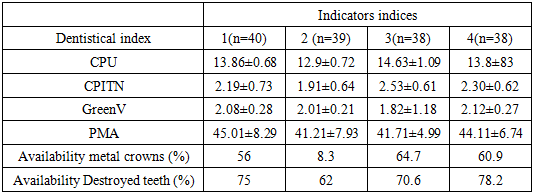-
Paper Information
- Previous Paper
- Paper Submission
-
Journal Information
- About This Journal
- Editorial Board
- Current Issue
- Archive
- Author Guidelines
- Contact Us
American Journal of Medicine and Medical Sciences
p-ISSN: 2165-901X e-ISSN: 2165-9036
2025; 15(4): 952-955
doi:10.5923/j.ajmms.20251504.22
Received: Mar. 3, 2025; Accepted: Mar. 27, 2025; Published: Apr. 6, 2025

The Influence of Initial Dental Status on the Development of Mucositis in Oncohematological Patients Receiving Chemotherapy
Latipova Sitora Bakhodirovna1, Turaeva Firuza Abdurashidovna2
1Bukhara Regional Specialized Dental Center Children's Therapist Dentist, Bukhara, Uzbekistan
2Bukhara State Medical Institute, Bukhara, Uzbekistan
Correspondence to: Turaeva Firuza Abdurashidovna, Bukhara State Medical Institute, Bukhara, Uzbekistan.
| Email: |  |
Copyright © 2025 The Author(s). Published by Scientific & Academic Publishing.
This work is licensed under the Creative Commons Attribution International License (CC BY).
http://creativecommons.org/licenses/by/4.0/

This paper presents the results of a clinical study of the dental status of patients with oncohematological diseases undergoing chemotherapeutic treatment. Examination of 156 patients suffering from diffuse large B-cell lymphoma and acute myeloblastic leukemia, showed a high level of dental morbidity before the start of chemotherapy. An analysis of the relationship between the initial dental indicators and the severity of mucositis developing against the background of chemotherapy was carried out. It was found that the presence of destroyed teeth, metal structures and a high index of oral hygiene significantly increase the risk of developing severe forms of mucositis. Dental risk groups were identified, which is of practical importance for the development of preventive measures and increasing the effectiveness of complex treatment of cancer patients. The results of the study emphasize the need for mandatory oral sanitation before the start of chemotherapy.
Keywords: Oncohematological diseases, Chemotherapy, Dental status, Mucositis, KPU index, Oral hygiene, Dental risk, Prevention
Cite this paper: Latipova Sitora Bakhodirovna, Turaeva Firuza Abdurashidovna, The Influence of Initial Dental Status on the Development of Mucositis in Oncohematological Patients Receiving Chemotherapy, American Journal of Medicine and Medical Sciences, Vol. 15 No. 4, 2025, pp. 952-955. doi: 10.5923/j.ajmms.20251504.22.
Article Outline
1. Introduction
- According to the World Health Organization (WHO), more than 19 million new cases of cancer are registered annually in the world, of which about 10 million are fatal. [1-3] In the structure of malignant neoplasms, a special place is occupied by hemoblastoses - malignant lesions of the hematopoietic and lymphatic systems, among which the most common are diffuse large B-cell lymphoma and acute myeloblastic leukemia. [6] With the development of oncohematology and the widespread introduction of chemotherapy into clinical practice, the duration and quality of life of patients has increased significantly. [5] However, side effects accompanying chemotherapeutic treatment, including those from the oral cavity, remain an urgent clinical, medical and social problem. [2]As noted by S.A. Borisenko (2014), “oral complications during chemotherapy can significantly reduce the quality of life of cancer patients, contribute to secondary infection and often require suspension of the main antitumor treatment.” These patients especially often develop mucositis - inflammation of the oral mucosa, the severity of which depends on both the chemotherapy regimen and the initial dental condition of the patient. [3]According to E.M. Kuzmina (2009), "the initial dental status of the patient has a direct impact on the risk of development and severity of mucositis during antitumor treatment", which requires mandatory dental examination and sanitation before the start of chemotherapy. [4] However, in practice, the preparation of cancer patients for treatment in the dental aspect is often ignored or carried out formally. [5]In the Republic of Uzbekistan, issues of dental support for oncohematological patients are not sufficiently covered in scientific literature, and standardized protocols for the prevention and treatment of complications in the oral cavity during chemotherapy are only beginning to be implemented. [6] As clinical practice shows, most patients are admitted for treatment without preliminary sanitation of the oral cavity, with a high prevalence of caries, periodontal diseases and the presence of destroyed teeth and metal orthopedic structures.Taking into account the above, the relevance of this study is due to the need for a comprehensive assessment of the dental condition of oncohematological patients, identifying the relationship between the initial dental indicators and the severity of mucositis, as well as substantiating approaches to the formation of dental risk groups. [7] This will not only improve the quality of medical care, but also ensure a multidisciplinary approach to the management of this category of patients.This study was conducted at the Department of Dentistry of the Bukhara State Medical Institute in collaboration with the Bukhara Regional Oncology Dispensary and covers the period from 2014 to 2022. The study analyzed dental indicators in 156 patients with oncohematological diseases at various stages of chemotherapy. The data obtained formed the basis for a differentiated approach to the prevention and treatment of mucositis, and also made it possible to identify high dental risk groups.Objective of the study. The objective of this study is a comprehensive assessment of the dental status in patients with oncohematological diseases (in particular, with diffuse large B-cell lymphoma and acute myeloid leukemia) receiving chemotherapy, as well as determining the relationship between baseline dental parameters and the severity of mucositis. In addition, the objective is to identify dental risk groups in order to develop effective preventive measures and optimize dental care for these patients.
2. Material and Method of the Study
- This study was conducted at the Department of Dentistry of the Bukhara State Medical Institute. The study sample included 156 patients receiving chemotherapy for hemoblastoses, such as diffuse large B-cell lymphoma and acute myeloid leukemia. The sample included 156 cancer patients at stages I - IV who received chemotherapy from 2014 to 2022 at the Bukhara Regional Oncology Dispensary of the Ministry of Health of the Republic of Uzbekistan.
3. Results of the Study
- The level of dental condition in patients with oncological diseases was assessed during the initial examination using standard dental indices in accordance with established methods.To assess the severity of mucositis in patients, the CTCAE v.4.03 toxicity scale (Common Terminology Criteria for Adverse Events), which was released by the National Cancer Institute in 2010. The severity of mucositis was determined as part of systematic dental examinations before and after each course of chemotherapy.
|
|
|
 | Figure 1. Original state oral cavities at oncological patients |
|
 | Figure 2. Dental risk groups |
4. Conclusions
- The conducted study allowed us to establish that the initial dental status of most patients with oncohematological diseases admitted for chemotherapy is characterized by high intensity and prevalence of caries, poor oral hygiene, the presence of decayed teeth and metal orthopedic structures. At the same time, none of the patients underwent preliminary oral sanitation before the start of antitumor treatment.Analysis of the relationship between the severity of mucositis and initial dental indicators showed that the presence of decayed teeth, a high KPU index, a high hygiene index (Green V), and the presence of metal structures significantly increase the risk of developing severe forms of mucositis. Based on the data obtained, dental risk groups were identified, which is important for predicting complications and planning preventive dental measures.Thus, the results of the study highlight the need to implement standardized dental examination and oral sanitation before chemotherapy in cancer patients. This will not only reduce the frequency and severity of mucositis, but also increase the effectiveness of the main treatment, improving the overall quality of life of patients.
 Abstract
Abstract Reference
Reference Full-Text PDF
Full-Text PDF Full-text HTML
Full-text HTML


